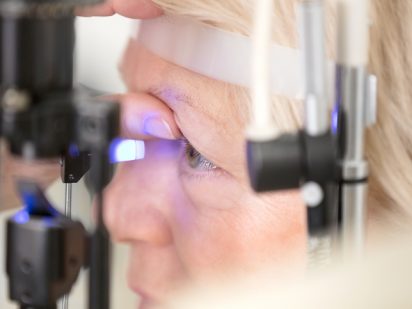When one thinks about rehabilitation following a stroke, most people may think about the physical aspects, such as learning how to walk again. Or perhaps it is speech related, learning how to talk. While physical, occupational, and speech therapy are all important parts of post-stroke rehabilitation, Lucy Templer, PT, MPT, Trinity Health, offers something unique to the region: visual therapy.
“A variety of vision problems can occur following a stroke,” she said. “According to the American Stroke Association, up to two-thirds of people experience some changes to their vision after a stroke. If you have a vision loss after a stroke, it can make your return to daily activities much more challenging.”
Vision problems can improve over time, as the brain recovers, Templer noted. “It is important to have a thorough evaluation of the eye by an ophthalmologist to identify any damage which may have occurred to the eye itself.”
Vision is affected depending on where the stroke occurs in the brain. “Every stroke presents differently,” said Jerilyn Alexander, RN, Stroke/STEMI coordinator with Trinity Health. “Oftentimes, if it is in the area that controls vision or affects nerves in the eyes, it can completely take away part of the visual field, where you actually have a cut in your visual field and see inward but not outward.”
Or, as Alexander noted, it can cause people to have vestibular function, where they would need gait stability exercises.
The most common visual problems after stroke are central or peripheral visual field loss, eye movement problems, visual processing problems, and visual neglect. Strokes can also affect the areas of the brain controlling balance and equilibrium, causing vertigo, dizziness, and difficulty with gait stability.
Possible visual problems post stroke may include:
• Blurred vision
• Double vision
• Difficulty with depth perception
• Loss of peripheral or central fields of vision
• Visual neglect of one side of the body
• Inability to move both eyes together
• Eyes wobble or move constantly (nystagmus)
• Light sensitivity
• Dry eyes
• Intolerance to high sensory environments (bright lights, loud noises, crowds)
• Dysequillibrium or vertigo with head or eye movement, risk of falls
After a thorough evaluation by a neurologist and ophthalmologist, physical therapy can be an important intervention in recovery.
“Exercises can be performed to strengthen eye movement and coordination, improve depth perception, and improve visual field awareness,” Templer said. “A comprehensive balance assessment is also performed to identify risk for falls. Exercises and activities will emphasize balance and equilibrium to improve movement patterns for greater stability.”
An ophthalmologist or optometrist may recommend prism lenses to help compensate for visual loss. A variety of computer programs are also available online to assist with training daily.
Vision loss can affect your safety and independence. Vision therapy can be an important part of your return to function after stroke. Be sure to consult your medical team to find the best path to your recovery.

